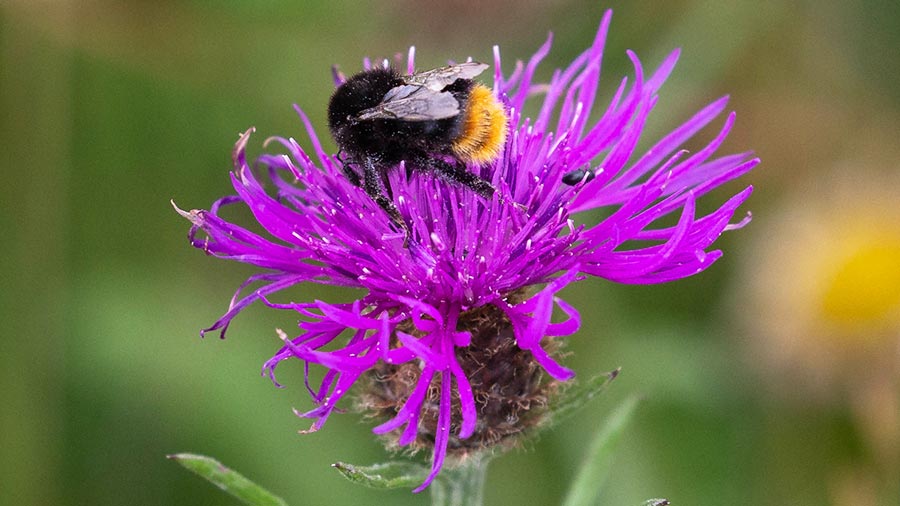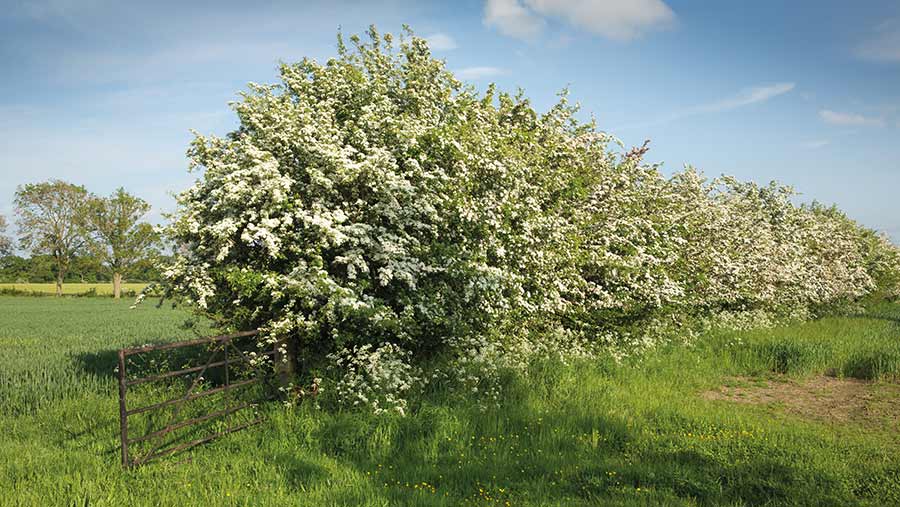Tips on establishing perennial wildflower strips for bees
 © Tim Scrivener
© Tim Scrivener Establishing perennial wildflower strips is one way to attract bees into fields, but sometimes it can prove frustrating, with some species failing to establish, limiting the value to pollinators.
Bees need both pollen and nectar: pollen is for their larvae and nectar provides energy.
Bees also need diversity, and farmers should aim to cater for short- and long-tongued bees, says independent agroecologist Dr John Holland, who is also the co-ordinator of the EU-funded Beespoke project (see below).
See also: How to establish in-field flowering strips to manage pests
For example, most solitary bees have short tongues so need more open flowers than long-tongued bumblebees.
John points to research comparing farms with Higher Level Stewardship, including flower-rich options, with those with Entry Level Stewardship and no flower margins.
Researchers found twice as many bees in the former.
The Beespoke project is developing more targeted mixes for different bee species such as bumblebees, which could prove valuable for bean growers.
Here are some tips published by Beespoke on how to successfully establish perennial wildflower strips.
Seed selection
- Use a native perennial mix, with at least 10 wildflower species and less than 15% (by seed weight) of less-competitive grasses (such as crested dogstail). Sow at 1g/sq m if more flower seeds are included.
- Use wildflower species with a range of floral structures, colours and flowering times to support a broad range of beneficial insects.
- Tailor the seed mix to your area, soil type, exposure to sun/shade, drainage etc. Seed companies produce a range of seed for different conditions. Also think about what you are aiming to deliver: for example biodiversity, pollination, pest control, etc.
- Avoid plant species known to benefit pests. Use native wild seed rather than agricultural varieties for greater habitat persistence.
Preparation
- Prepare a firm, fine, weed-free seed-bed for broadcasting seed, ideally in late summer (August/September). A second (less successful) option is to sow in spring (March/April).
- Ensure that pernicious weeds are completely controlled before sowing – this may take more than one season.
- For successful wildflower establishment, avoid shaded areas, high soil fertility and land prone to waterlogging. Also remove dense ground cover, such as grasses, using machinery during a dry period, or treat with a contact broad-spectrum herbicide. Then harrow-cultivate the soil, bringing weed seeds to the surface.
- Create a stale seed-bed, allowing weed seeds to germinate, and then eliminate by mechanically weeding/harrowing or a non-residual herbicide. Be aware that some herbicides can persist in the soil and damage the flowering crop that follows.
Sowing
- Broadcast the seed, do not drill, as drilled seed goes dormant. Use a mechanical broadcaster, a drill lifted clear of the ground, or broadcast by hand according to seed company recommendations.
- Mixing the seed with sand, barley or wheat meal enables more even distribution when sowing by hand.
- Roll the area to firm the seed-to-soil surface, ideally just before rain is due.
Maintenance
Year one (establishment year)
- After autumn sowing, a spring cut in late April at 8-10cm height is useful to control grass and encourage sown species to establish.
- Repeated mowing may be needed if annuals shade out sown species. If some annual flowers are included, do not cut in the first year unless they shade out the seeds of perennials that still need to germinate and grow.
Year two onwards
- A spring cut in late April at 8-10cm height might be needed, and a second cut late August/early September to 8-10cm. Consider cutting half the plot in late June to encourage more flowering.
- Ideally, and for greater success, collect cuttings to reduce grass dominance, improve wildflower persistence and remove thatch.
- Monitor wildflower areas and spot-treat pernicious weeds such as docks and thistles, but avoid using herbicides when possible. Avoid drift of fertiliser, herbicide and other pesticides into wildflower areas.
Other ways to help bees

© Tim Scrivener
While flower-rich margins are the best at attracting pollinators, they can also be supported by other habitats typically found on farms, such as hedges, trees and uncultivated field corners. Examples include:
- Log piles These can provide habitat for leaf-cutter bees as they can excavate rotting wood to create nests.
- Shrubby areas Species such as hawthorn, hazel, dogwood, wild privet and crab apple are valuable as they will flower most of the summer and will offer pollen. The abundance of fruit and seed will help songbirds.
- Crimson clover and other flowering species can be used in a green cover to fill in bare ground.
- Water/ponds These will benefit pollinators because bees need water. They don’t need to be large, but must hold water for most of the year. At Loddington, wildflower seed was broadcast on the banks to offer more for pollinators.
- Trees While they can be a pain for sprayer operators and tractor drivers, large trees such as horse chestnut within fields are a good nectar source and are early flowering, giving bees some early season food.
- Stacking margins Consider having a range of habitats in a small area. Cover all bases for as many species as possible. If there is a hedge with a grass margin, why not consider having a pollen strip and a bird food strip next to each other to give a valuable resource.
- Hedges Consider cutting every other year to allow more flowering.
Beespoke project
The Beespoke project is a four-year scheme funded by the EU and covering seven countries in northern Europe.
Its overall aim is to increase the number of pollinators and crop pollination by providing new expertise, tools and financial knowledge to land managers and policymakers.
Researchers are developing products and approaches to increase the diversity of insect pollinators and crop yields by 10%.
This includes bespoke seed mixes and habitat management guidelines to support the suite of pollinators required for 14 crop types on 72 demonstration sites. For more information, go to www.northsearegion.eu/beespoke.
Did you know?
Bumblebees are better for pollinating field beans than honeybees or solitary bees, because they have longer tongues to reach into the flower.
Shorter-tongued bees tend to make a hole and rob nectar without entering the flower and picking up pollen, so they are less efficient at pollinating crops.
